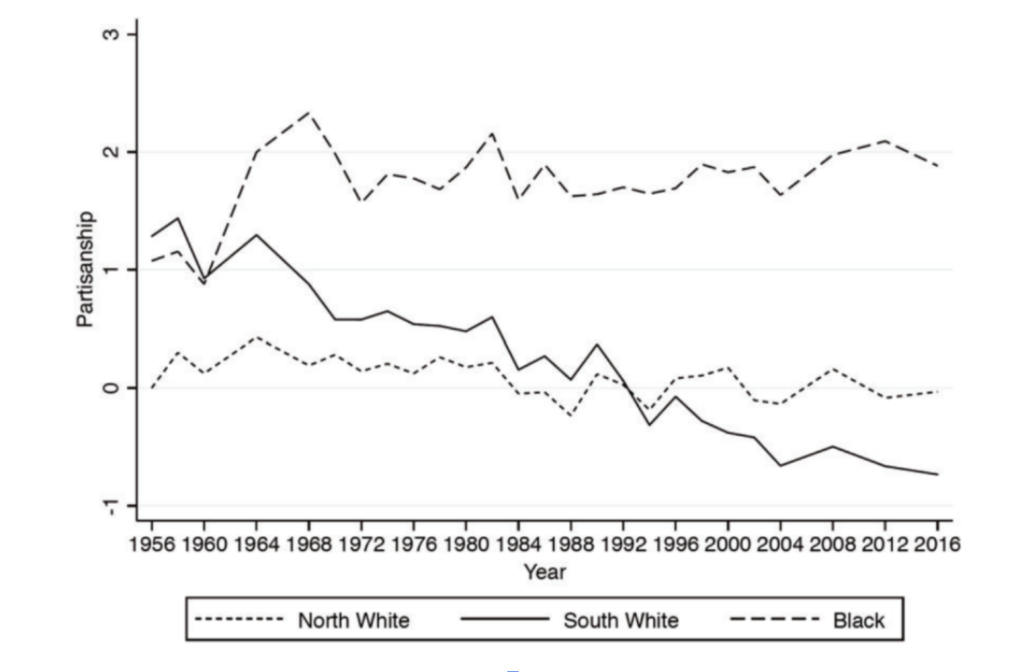How Voter Loyalties Change
This post was developed by Ken Kollman and Tevah Platt, based on the talk, “When People Change Their Partisanship, is it Bottom-Up or Top-Down?” that Ken Kollman presented for the Research Center for Group Dynamics Winter Seminar Series on Political Polarization (2023) at the University of Michigan Institute for Social Research. Ken Kollman is the Director of the Center for Political Studies.

Partisanship is sticky. People tend to vote like their parents and to maintain their partisan leanings over time. But to understand partisanship, we need a model that can explain why people change party loyalties when they do. This is what Ken Kollman and John E. Jackson of the University of Michigan Center for Political Studies (CPS) provide in Dynamic Partisanship: How and Why Voter Loyalties Change. The following summarizes their overarching argument.
What is partisanship?
Partisanship is a group-based, shared identity. A classic work from 1960, The American Voter, also out of ISR, describes partisan identity as a long-term, affective, psychological attachment to a political party. According to this famous “Michigan model,” the socially-informed attitudes and values we form early in life durably influence the way we identify with political parties and how we vote.
Kollman and Jackson argue that partisanship has similarities to brand loyalty. It’s relatively stable and habitual, but it’s also evaluative and cognitive. Parties compete for votes and, importantly, for voter loyalty among “consumers” who are considering and comparing candidates and party ideas. Voters “experience” parties in office and in campaigns, and evaluate parties like consumers with products. Yet voting over time for the same party can also become habitual until voters become dissatisfied with what they chose.
What drives partisanship change?
Ronald Reagan often said that he didn’t leave the Democratic party, but the Democratic party left him. The quip encapsulates what Kollman and Jackson find to be the primary answer to the question of what moves partisanship. Two other processes do influence partisan dynamics– changes in people’s political attitudes and their evaluations of the performance of politicians in office – but it’s the behaviors of parties that they find are the greatest contributors to changing partisanship.
- At the micro-level, partisanship is driven by evaluations of parties and politicians who are themselves changing for strategic reasons to try to win office.
- At the macro-level, party polarization is a consequence of elite-level competition for voters, mostly at a national scale– for example, in response to national policies and movements.
In the broader debates about polarization, the stake they claim is that polarization is driven by elite-level competition for power, and not by ordinary people changing their minds about their ideologies or issue positions. It’s top-down, driven by what politicians and their parties do.
How parties compete
A canonical model of party competition came out of the mid-century work of Anthony Downs, who developed a theory of party competition in ideological space. This theory drew a picture of the Democratic and Republican parties converging on the “median voter” the way that ice cream trucks would converge at the middle of a beach to attract the most customers. More complex models admit that political ideology and conflict takes place in multiple dimensions; on the ground, for example, a candidate or party that is moving right on social issues could be moving left on economic policy, perhaps testing out impacts on voters.
A case in point: the language of industrial protectionism (saving factories) was an economically leftward move of the Trump-guided GOP that effectively turned Ohio from purple to red by attracting whites in Northeastern Ohio to the Republicans. Dynamic Partisanship tracks such patterns across the US, the UK, Canada and Australia over more than a half-century, but the overarching trend is that parties are the moving gear in dynamic partisanship. Voters don’t need to be moved, but partisanship can change because voters are reacting to parties that move– and that’s the underlying dynamic.
Partisan trends in the US

This figure, from Dynamic Partisanship, plots partisanship among three groups of the U.S. electorate– northern whites, southern whites, and African Americans– from 1956 to 2016, with Democratic partisanship increasing on the y axis. There are three distinct patterns:
- Northern white partisanship is the most stable, coming closest to the traditional view of party identification as an unchanging personal attribute;
- The 1964 election, on the heels of the passage of the Civil Rights Act, is a critical turning point in African American partisanship, making a full-point leap and remaining consistently high on the Democratic scale from that time;
- Southern white partisanship shows a strong, gradual trend shifting from moderately Democratic to weakly Republican over 61 years.
The twin phenomena of southern Black voters becoming more Democratic since the 1960s and southern whites becoming slowly more Republican over time represent two of the major tectonic shifts in American society and politics that have occurred in the last half century.
The innovation is that the model used in Dynamic Partisanship can accommodate these divergent patterns– relative stasis, abrupt changes, and gradual changes. For the details and the myriad examples, check out the book.

